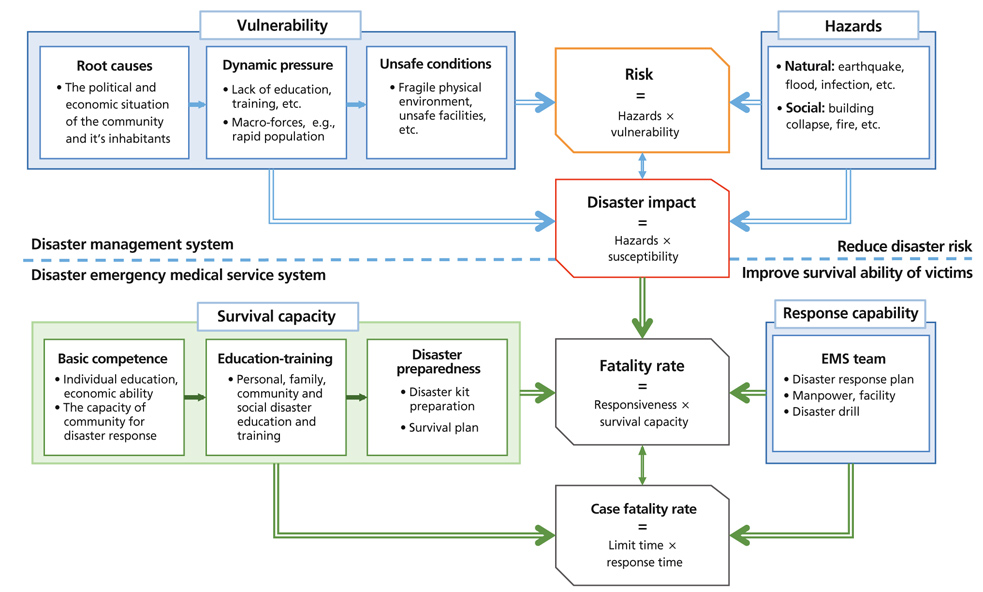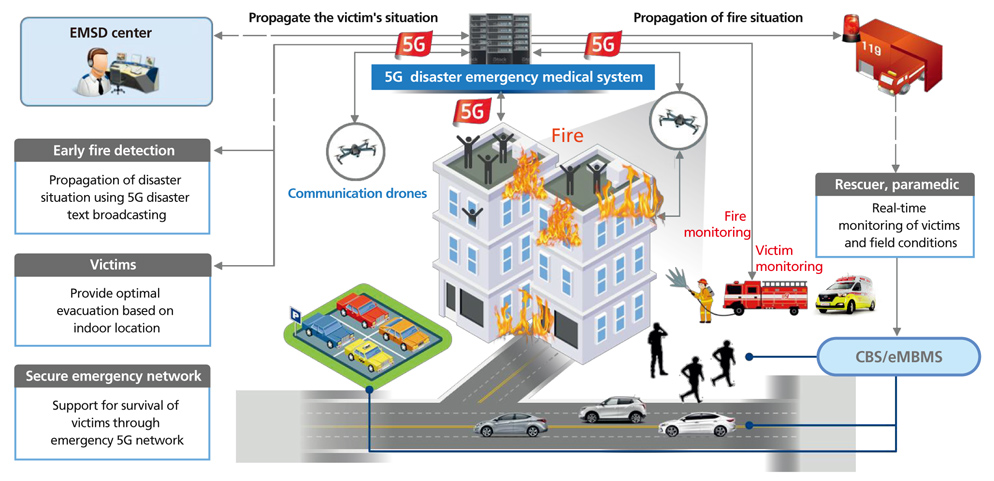J Korean Med Assoc.
2019 May;62(5):258-264. 10.5124/jkma.2019.62.5.258.
Victim-oriented digital disaster emergency medical system
- Affiliations
-
- 1Department of Emergency Medicine, Chuncheon Sacred Heart Hospital, Hallym University College of Medicine, Chuncheon, Korea. skyahn@hallym.or.kr
- KMID: 2445790
- DOI: http://doi.org/10.5124/jkma.2019.62.5.258
Abstract
- The fatality rate of a disaster is associated with the impact of the disaster and the case fatality rate. The severity of the disaster can be reduced by an efficient disaster management system, and the capacity of the trained disaster response system can lower the case mortality rate. The severity of a disaster is determined by the interaction of risk factors and vulnerabilities in a particular area, and the case-fatality rate is determined by a correlation between the capacity of the disaster response team and the survivability of the victims. The disaster management system and the disaster response system are complementary and interconnected, and the efficiency of cooperation and linkage can be improved by developing well organized digitalization. Efforts to increase the survival rate of victims through digitalization has been a continued process and new alternatives are being developed in accordance with the advances in information and communication technology to manage disaster risk factors and to improve disaster response capabilities. However, in case of mass casualty incidents, it is still difficult to reduce the case mortality rate by securing the survival time limit of the victims. Often, sharing the disaster scene information and communicating with the victim is not feasible. A lack of ability to provide real time escape route to exit or safe zone proves fatal. The communication revolution of the next generation wireless wide area network called 5G can overcome the disruption of communication network during the disaster incidents. It can enable real time tracking of the position of victim and linking the victims with its rescuers. Hence, it is possible to increase the survival rate of victims during mass casualty incidents by associating information and communication technologies with appropriate disaster management and response strategies, real-time information exchange and education and training of rescuers and citizens.
Keyword
MeSH Terms
Figure
Reference
-
1. Perry RW, Lindell MK, Tiemey KJ. Facing the unexpected: disaster preparedness and response in the United States. Washington, DC: Joseph Henry Press;2001.2. Peek-Asa C, Ramirez M, Seligson H, Shoaf K. Seismic, structural, and individual factors associated with earthquake related injury. Inj Prev. 2003; 9:62–66.
Article3. Kunii O, Akagi M, Kita E. The medical and public health response to the Great Hanshin-Awaji Earthquake in Japan: a case study in disaster planning. Med Glob Surviv. 1995; 2:214–226.4. Winberg D. International fire death rate trends. Boras: SP Technical Research Institute of Sweden;2016.5. Hamins A, Averill J, Bryner N, Gann R, Butry D, Davis R, Amon F, Gilman J, Maranghides A, Mell W, Madrzykowski D, Manzello S, Yang J, Bundy M. Reducing the risk of fire in buildings and communities: a strategic roadmap to guide and prioritize research. Gaithersburg: National Institute of Standards and Technology;2012.6. Jassempour K, Shirazi KK, Fararooei M, Shams M, Shirazi AR. The impact of educational intervention for providing disaster survival kit: applying precaution adoption process model. Int J Disaster Risk Reduc. 2014; 10:374–380.
Article7. United Nations International Strategy for Disaster Reduction. Disaster reduction and sustainable development: understanding the links between vulnerability and risk related to development and environment. New York: United Nations;2002.8. Wisner B, Blaikie P, Cannon T, Davis I. At risk: natural hazards, people's vulnerability and disasters. 2nd ed. London: Routledge;2004.9. United Nations International Strategy for Disaster Reduction. Living with risk: a global review of disaster reduction initiatives. New York: United Nations;2004.10. National Emergency Medical Center. Disaster response system [Internet]. Seoul: National Emergency Medical Center;2013. cited 2019 Jan 18. Available from: http://www.e-gen.or.kr/nemc/disaster_respondence_system.do.11. Federal Emergency Management Agency. Are you ready? An in-depth guide to citizen preparedness [Internet]. Jessup: Federal Emergency Management Agency;2004. cited 2019 Jan 18. Available from: http://www.fema.gov/pdf/areyouready/areyouready_full.pdf.12. Ministry of the Interior and Safety. Statistical yearbook 2017. Sejong: Ministry of the Interior and Safety;2018.13. Ginige A, Paolino L, Romano M, Sebiilo M, Tortora G, Vitello G. Information sharing among disaster responders: an interactive spreadsheet-based collaboration approach. Comput Supported Coop Work. 2014; 23:547–583.
Article14. Aedo I, Diaz P, Carroll JM, Convertino G, Rosson MB. End-user oriented strategies to facilitate multiorganizational adoption of emergency management information systems. J Inf Process Manag. 2010; 46:11–21.
Article15. Diaz P, Aedo Romano M, Onorati T. Supporting citizens 2.0 in disasters response. In : Proceedings of Conference on Methodologies, Technologies and Tools enabling e-Government (MeTTeG 2013); 2013 Oct 17-18; Vigo, Spain. p. 1–10.16. Romano M, Onorati T, Diaz P, Aedo I. In : Hilttz SR, Pfaff MS, Plotnick L, Shih PC, editors. Improving emergency response: citizens performing actions. Proceedings of the 11th International ISCRAM Conference; 2014 May; University Park, PA, USA. p. 170–174.17. Cai G, Bolelli L, MacEachren AM, Sharma R, Fuhrmann S, McNeese M. GeoCollaborative crisis management: using maps to mediate EOC: mobile team collaboration. In : Proceedings of the 2004 Annual NFS Digital Government Conference; 2004 May 24-26; Seatle, WA, USA. p. 48.18. Velev D, Zlateva P, Zong X. Challenges of 5G usability in disaster management. In : Proceedings of the 2018 International Conference on Computing and Artificial Intelligence; 2018 Mar 12-14; Chengdu, China. New York: ACM;2018. p. 71–75.19. Markakis EK, Lykourgiotis A, Politis I, Dagiuklas A, Rebahi Y, Pallis E. EMYNOS: next generation emergency communication. IEEE Commun Mag. 2017; 55:139–145.
Article



